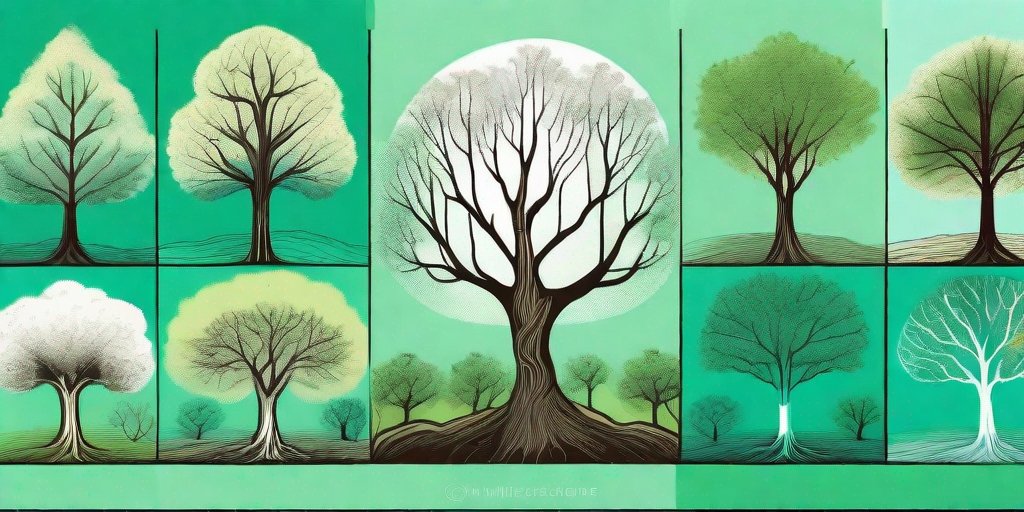
Trees are like the stoic sentinels of our gardens, standing tall through all seasons, weathering storms and basking in the sun. But even these hardy perennials can fall victim to disease, pests, or simply old age. So, how do you know when your tree has kicked the bucket? Fear not, dear reader, for we have compiled a foolproof guide to help you spot a dead tree.
Understanding the Signs of a Dead Tree
Before we dive into the nitty-gritty, let's get one thing straight: trees are tricky. They don't keel over and play dead at the first sign of trouble. Instead, they often soldier on, showing subtle signs of distress. So, you'll need to play detective and look for these signs.
But don't worry, you won't need a magnifying glass or a deerstalker hat (unless you want to, of course). All you need is a keen eye and a bit of patience. So, let's get started, shall we?
Leaf Trouble
Leaves are like the tree's little flags, waving in the wind and showing off their health. If the leaves are discolored, wilted, or falling off prematurely, it might be a sign of a problem. But remember, some trees are drama queens and shed their leaves at the slightest change in weather. So, don't panic just yet!
On the other hand, if your tree is looking bare when it should be in full leaf, or if the leaves are brown and crispy but stubbornly clinging to the branches, it's time to raise an eyebrow. This could be a sign of a serious issue.
Bark Peeling or Cracking
Bark is like a tree's armor, protecting it from the elements and pests. If the bark is peeling, cracking, or falling off, it could be a sign that your tree is in distress. But again, don't jump to conclusions. Some trees naturally shed their bark. So, you'll need to know your tree's habits before you start planning its funeral.
However, if the tree's bark is falling off and the underlying wood is dry and brittle, it's a clear sign of a problem. Similarly, deep cracks or splits in the bark are not a good sign. If you see these symptoms, it might be time to call in the professionals.
Performing a Scratch Test
Now that you know what signs to look for, let's move on to a simple test you can perform to check your tree's health: the scratch test. It's as easy as it sounds and doesn't require any special tools. All you need is your fingernail and a bit of courage.
Simply scratch a small area of bark from the tree's trunk. If the underlying wood is green and moist, your tree is alive and kicking. If it's brown and dry, I'm afraid it's bad news. But remember, this is just a test. Don't go scratching off all the bark in a panic!
How to Perform the Scratch Test
- Choose a spot on the tree's trunk or a branch. It should be easy to reach and not too high up.
- Using your fingernail or a small knife, gently scratch off a small piece of bark. Be careful not to injure yourself or the tree.
- Look at the underlying wood. If it's green and moist, your tree is fine. If it's brown and dry, it might be dead or dying.
When to Call in the Professionals
If you've spotted the signs of a dead tree and confirmed it with the scratch test, it might be time to call in the professionals. But don't rush to dial the number just yet. There are a few things you need to consider.
Firstly, is the tree a danger to your property or the people around it? If it's leaning precariously or has large, dead branches, it might be a safety hazard. In this case, it's best to call in a professional arborist as soon as possible.
Secondly, is the tree protected by local laws or regulations? Some trees are protected and cannot be cut down without permission. If you're unsure, check with your local council or a professional arborist.
Frequently Asked Questions
Can a dead tree come back to life?
Unfortunately, once a tree is dead, it can't be revived. However, a tree can often look dead when it's simply dormant or stressed. So, it's important to correctly identify a dead tree before taking any drastic actions.
Can I cut down a dead tree myself?
While it might be tempting to grab a chainsaw and go to town, cutting down a tree can be dangerous and is best left to the professionals. They have the right equipment and training to do the job safely and efficiently.
How can I prevent my tree from dying?
Regular care and maintenance can help keep your tree healthy. This includes watering, fertilizing, pruning, and protecting it from pests and diseases. If you're unsure about how to care for your tree, consider hiring a professional arborist.
So, there you have it, a foolproof guide to spotting a dead tree. Remember, trees are resilient and can often bounce back from stress or disease. So, don't be too quick to write off your tree. But if it is indeed a goner, don't despair. It's a chance to plant a new tree and start a new chapter in your garden's story.















